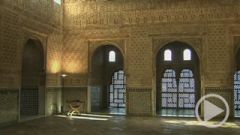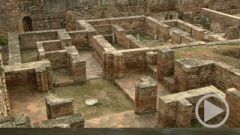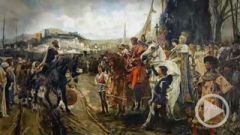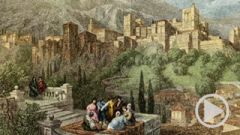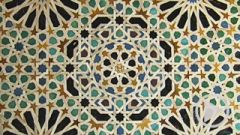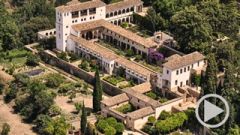The Fall of the Nasrids
The Fall of the Nasrids
The 19th of October 1469 – date of a royal wedding at the Valladolid Palace. Ferdinand of Aragon is marrying Isabella of Castile. This suddenly unites Granada’s two main enemies. In 1482, Pope Sixtus IV. issues a papal bull calling for a crusade against Granada. Now the Reconquista consolidates its forces for the decisive strike against Granada. The Catholic Kings relocate their army camp and call it Santa Fe, or holy faith – today a town. The name says it all.
In the year 1491, just 15 kilometres separate the besiegers from the Alhambra. Head of the household here at the time is the son of Abu l-Hasan Ali, Muhammad XII. Records also refer to him as Boabdil – and he is to be the last sultan of the Nasrid empire.
The situation is desperate. The siege soon leads to food shortages. And the mounted troops are simply not strong enough to deliver any kind of liberating blow. Eventually, a delegation of influential Muslims calls on the Sultan to order an honourable capitulation. The opposing camps negotiate for weeks until the conditions for handover are agreed upon and set down in writing. And those conditions don’t sound too bad at all: The Catholic kings pledge to allow their opponents the right to practice their religion freely, independent courts for the Moors, a general amnesty and no further tax hikes.
On 2nd January 1492, Isabella and Ferdinand move into the Alhambra – through a side door. In a gesture of humility, Boabdil kisses the monarch’s hand. From now on, the standards of the Catholic kings fly from the Vela Tower.
This is actually a stroke of luck for future generations – the Alhambra is so well preserved because the handover occurred without any violence.
As legend would have it, Boabdil took a final look at the Alhambra from a hilltop – with tears in his eyes. To this day, there is a pass to the south of Granada called “El suspiro del moro”, the Moor’s sigh. His mother is said to have scolded him: “What are you doing blubbing like a woman over the loss of a city you weren’t man enough to defend?” A few years later, the last emir left al-Andalus and headed to Morrocco. The 700-year history of Islamic culture on the Iberian Peninsula had finally come to an end.
Christianity triumphed. And took possession of the spoils. Initially, the Catholic Kings lived at the Alhambra as though under siege – the Muslim city beyond its walls was hostile to their presence. But they got on with the business of settling in.

One of the first changes was the construction of a huge cistern. The new rulers didn’t understand the Nasrids’ elaborate water system. And there was no one to help them comprehend it either, as not only had the members of the royal household been expelled, but all the residents of the medina as well.
The magnificent mosque was immediately converted into a church. It was later to become Santa Maria de la Alhambra. The conquerors stamped the Alhambra with the indices of victory: Plus ultra, “beyond the known boundaries of the world” – was the motto of the Catholic Kings. They were fascinated by the architecture of the Moors. But as much as they respected it, they wanted to customise it.
The same could be said of the grandson of the Catholic Kings, Charles V. Newly elected as emperor of the Holy Roman Empire, he visited the Alhambra in 1526. Deeply impressed, he declared that Granada should become an imperial seat within his empire on which the sun never set.
He initially ordered some reconstruction work for himself and his spouse, Isabel of Portugal. The new rooms are known today as the “Emperor’s Chambers”.
This tower is referred to in common parlance as the “Queen’s Dressing Room”. The rulers really spoiled themselves here. Underfloor heating sent warm air flowing upwards into the room above. The decorative features are in Moorish style below, and unabashed Rennaissance above – fresco painting the like of which you would expect to find in Italy. One motif is especially telling – a depiction of the conquest of Tunisia in the year 1536 by the imperial armada. Charles is showing off his own superiority.

But there was still a need to create something momentous, a symbol: a palace, massive and powerful. In a completely different architectural style to the gracious Nasrid palaces. As emperor of the Holy Roman Empire, Charles V. was successor to the Roman imperators. Rennaissance architects looked to Classical Antiquity for their inspiration.
In 1527 Pedro Machuca, a pupil of Michelangelo and Raffael, began building a palace. Charles left the old palaces standing as a yardstick by which to gauge the size of the new. He documented his aspirations on the façade: two goddesses of victory hold the globe and the pillars of Hercules – in ancient legend these represent the cliffs of Gibraltar, the end of the habitable world. Two angels set fire to the weapons with their torches. They’re no longer needed: the Emperor has enforced universal peace.
But construction costs money, and funds were also required for the upkeep of the Nasrid palaces. That’s why the Emperor repeatedly raised taxes. Pressure on the Moriscos, or converted Moors, was stepped up. And not just financially – on 7 December 1526, the Granada city government had issued a decree:
The Moriscos were obliged to learn the Castilian language within three years. All contracts and documents in Arabic were null and void. All Morisco attire was banned. The wives of the Moriscos were to cease covering their faces. Religious cults were banned; bathhouses, both public and private, were to be destroyed.
The repressed Moriscos tried to defend themselves, and there were a number of rebellions and conspiracies – until 1609, when the Christian rulers finally expelled all Moors from the country. From that moment on, the Spanish crown imposed a “one empire, one faith” policy.
The move triggered a mass exodus towards Africa. The population of Andalusia fell by more than 300,000. The economic consequences were grave: Expertise was lost, no one was privy to the secrets of the Moors’ irrigation techniques. Farmland was left to fall barren. Work on the palace of Charles V. was finally halted in the year 1637. The Alhambra fell into rack and ruin.



